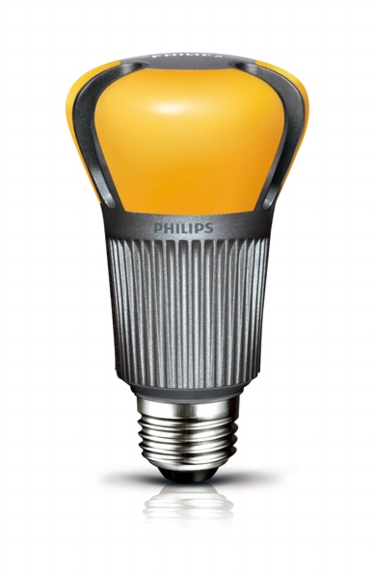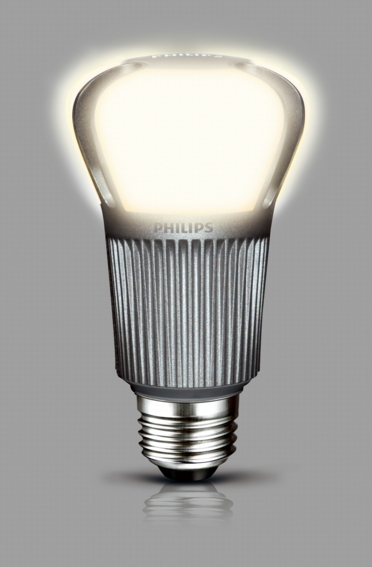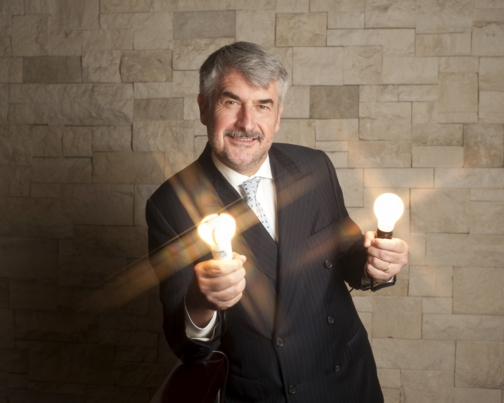Any updates on this product (when it will be available in the market? what the price will be?). I've been trying to find additional information but so far have turned up nothing... Thanks!
Blog Post
Philips 12-Watt EnduraLED Light Bulb

LEDs are light-emitting diodes. Many experts look to LEDs as the future of lighting. Unlike compact fluorescent lamps (CFLs), metal halide, and induction lamps, LEDs do not contain mercury, which is a toxic metal and disposal concern. LEDs are solid-state devices, utilizing semi-conductor technology.
Replacing the 60-watt incandescent light bulb is significant because there are so many of them. According to Philips, more than 425 million of these bulbs are sold each year in the U.S., representing approximately 50% of the domestic incandescent light bulb market. Replacing all of these with LEDs, like the Philips EnduraLED, would save more than 32 terawatt-hours of electricity per year, which is enough to power the lights of more than 16 million U.S. households and save 5.3 million metric tons of carbon emissions.
The EnduraLED produces 806 lumens of light using 12 watts of electricity, for an efficacy of 67 lumens per watt. This is about the same or slightly higher than the efficacy of most CFLs, while the expected life is longer and the light at least as good, if not slightly better, with a color rendering index (CRI) of 85. Also, unlike standard CFLs, the EnduraLED is fully dimmable.

The Philips EnduraLED is based on technology used in the company's September, 2009 submission to the U.S. Department of Energy L Prize--a competition to spur the development of a more efficient light bulb. There are two categories for the L-Prize: a replacement for the 60-watt incandescent light bulb and a replacement for a PAR-38 halogen lamp. For a 60-watt bulb replacement, the L-Prize requires entries to produce at least 900 lumens using less than 10 watts--for an efficacy of at least 90 lumens per watt. Other requirements include a CRI of more than 90, a color temperature between 2700 and 3000K (considered a warm-white light, similar to that produced by a 60-watt incandescent bulb), and a projected life of more than 25,000 hours.
Philips had the first--and so far the only--submission for the 60-watt light bulb replacement, which carries a $10 million reward. According to Casanova, DOE is expected to announce L-Prize winners in 2011, after conducting extensive testing of submitted products.
SUPPORT INDEPENDENT SUSTAINABILITY REPORTING
BuildingGreen relies on our premium members, not on advertisers. Help make our work possible.
See membership options »
We are witnessing a period of rapid advances in LED lighting technology. I fully expect to see LED light bulbs that meet the L-prize requirements fully on the market at a retail price in the $20-25 range (about that of early CFLs) within the next three to five years.
For more information:Philips Lighting North America
Burlington, Massachusetts
888-385-5742, 617-423-9999
www.lighting.philips.com/us_enI invite you to share comments on this blog. How low would the price of an LED light bulb have to drop for you to buy or specify it?
Alex Wilson is the executive editor of Environmental Building News and founder of BuildingGreen, LLC. To keep up with his latest articles and musings, you can sign up for his Twitter feeds.
Photos: Philips Lighting North America. The first photo shows the EnduraLED turned off; in the second it is switched on. The last photo shows Philips CEO Randy Provoost holding the EnduraLED and a 60-watt incandescent light bulb.
Published May 13, 2010 Permalink Citation
(2010, May 13). Philips 12-Watt EnduraLED Light Bulb. Retrieved from https://www.buildinggreen.com/news-article/philips-12-watt-enduraled-light-bulb
Comments
Sooner the better! Incandesc
Sooner the better! Incandescents will be banned soon, and CFL's - which are being pushed really hard right now - hopefully will be banned in 10.
The price of LED bulbs is inexplicable. I've been using LED headlamps and flashlights exclusively for 10 years; they have always been the cheapest light and have worked great. One could go to Walmart tomorrow and buy 10 flashlights for the price of a stupid bulb!
I sure hope the industry breaks from the past and offers a good selection of temperatures (ie, bright). Continually trying to re-create that dark and gloomy orange cast from an incandescent is a real mistake; there is less light output for more manufacturing trouble. Let there be light!
The key is the light output.
The key is the light output. What kind of light does the LED produce - spend $10 or $100 - if the kelvin temperature is not right you will not be happy with it in household applications. I just got back from a lighting trade show and hunted down the best lamp for household use. I found the Lemnis Pharox 300 is the best LED in the market. Here is a link if anyone is interested www.SOSLightBulbs.com
After seeing good light and bad (honestly a lot of Chinese product) - I really think most will be happy that they checked into color temperature before buying a bulb.
Why aren't LED replacement la
Why aren't LED replacement lamps really cheap, like flashlights? Heat management and color rendering! The color rendering of most LED flashlights is very poor and most people would not consider the color rendering acceptable. But more importantly, flashlights don't typically run for long periods of time and thus they don't need to be that concerned with heat management. The LED keychain light I bought recently is rated to last 12 hours!
Look at that Philips lamp and you'll see that the entire lower half about heat management. You'll often read that LEDs don't produce heat light incandescent or even fluorescent lamps. More accurately, they don't RADIATE heat like those lamps. They CONDUCT heat. If conductive heat transfer is not managed, the LED itself will fail in short order. So while in a lab an LED may last 60,000 hours, without good conductive heat management, it might not even last six months! See http://www.energystar.gov/index.cfm?c=lighting.pr_what_are#all_equal and look at the very last section.
I'm sorry, but I don't buy th
I'm sorry, but I don't buy the heat dissipation bit.
What are we talking about here? Just one-fifth of the heat generation of a 60W incandescent or a modern automobile headlamp bulb, neither of which needs any such fancy "heat sink" or protective basket.
With a little bit of real thought, that heat could easily be led away and dissipated via the power supply wires. Regular incandescent bulb fixtures are made of heat resistant materials because they have to deal with much more. And remember: how much heat is to be dissipated to keep the LED "guts" cool depends a lot on whether the fixture is designed for "cap up" (the more usual and arduous) or "cap down" operation.
Full marks and a big bouquet to Philips for producing a lamp that will be more robust and infinitely safer and "greener" than the CFLs which I love to hate; but there's a mighty big brickbat that goes with it for creating an over-"designed", pretty device which is much more of a revenue generation exercise than a cheap, mass-market, over-the-Wal-Mart-counter incandescent replacement. See my previous comments on CFL initial price points for "latest", "designer", "must-have" devices to attract "early adopters" who just have to be first with anything, whatever the price - and look at any book on Economics if you don't believe me.
If Philips wants to make a lot of money in a hurry, before the rest of the industry gets in on the act, it should keep the standard Edison Screw base of this bulb but do some really vicious value engineering to get the price down to a sensible level that will attract the millions of Americans left cash-strapped by the global financial meltdown to replace their incandescents and save 80% on their lighting bills.
OK. Here's another gripe, wh
OK. Here's another gripe, which you take a crack at explaining: The emphasis is on developing LED's with replacement bulb technology rather than original. In a recently completed project I expected to wire part of it with LED fixtures, but it was cheaper to buy edison base LED's and screw them into standard fixtures, rather than install LED dedicated fixtures.
This is idiotic. Besides that screw bases are antiquated technology, and the problems of heat management you allude to could partially be picked up by a redesigned housing, in terms of energy standards from Title 24 on down, as soon as you walk out the door the new owner can unscrew your precious $75 LED and replace it with a 99 cent glowing heat lamp from K-Mart.
What actually worked best on this project is LED rope lights. Other LED options were expensive, but the ropes are fun, contemporary, and reasonably priced.
Cute product. One of the bet
Cute product. One of the better replacement lamps I've seen available. And the price is out of the stratosphere range. I like seeing products aimed at the major culprits for wasted energy.
Tony, yeah, the "must-have" devices to attract "early adopters" are expensive. If it weren't for these early adopters not much would change technology wise. How expensive and bulky were early cell phones. If early adopters weren't willing to pay so much for these must-have devices the current cell phone wouldn't be as small and cheap as they are now. Laugh at the early adopters if you want, but we as a society all benefit from those who gotta have the latest and greatest. And the heat sinks are needed for LED longevity. Wires cannot be used as heat sinks because they are insulated, heat doesn't get out well. Also, the wires are heated from carrying electricity, adding more heat to the wires reduces their capacity to carry electricity.
Buzz, I agree. LED's and incandescent lamps throw light in very different ways and light fixtures should be designed to maximize the way light is emitted from the lamps, rather than trying to force a round peg into a square hole. While I think the LED replacement lamps are less than ideal they are a step in the right direction and are simple enough for most of the public to accept. Needing to hire an electrician to install a new LED fixture will scare many away from buying LED. Screwing in a new LED lamp into their existing fixture they can handle and they may consider buying LED.
Bill, You're right in your ar
Bill,
You're right in your argument about high prices for early adopters being beneficial in the long run by creating demand which forces prices down as quantities increase. However, in this case we're not talking about a "high end" device like a cell phone but something which should have been a mass market product from the word GO.
Don't get me wrong: I'm not against Philips making money from this device - I just think that it's wrong for them to try to make a huge per unit profit for a tarted-up product, when the world has at last woken up to the idea that we must start using less energy and post-crash economics mean that a relatively penniless public would jump at the chance of buying something "regular" which would save them significant ongoing expenditure.
Many readers of this blog may not realize that musicassettes and CDs exist because they were invented by Philips, who then let everyone else use them on free license. I believe that if Philips went at least part-way back to this philosophy and licensed this LED lamp to everyone else at a nickel or even a penny per unit, they would earn enough to laugh all the way to the bank - and good luck to them, because they would deserve it.
I guess we'll have to disagree on heat dissipation through wires - but they do sink heat from incandescents already; and if the NEC sticks to the same conductor sizes and we're drawing only one-fifth of the current, there's going to be lots of space for LED heat, isn't there?



Add new comment
To post a comment, you need to register for a BuildingGreen Basic membership (free) or login to your existing profile.